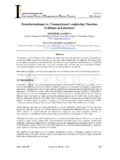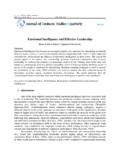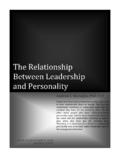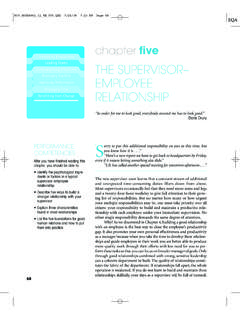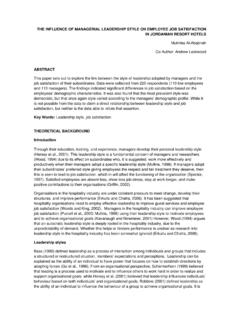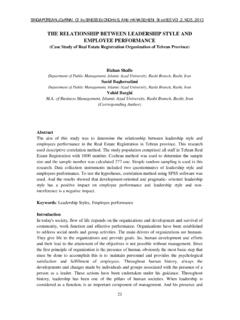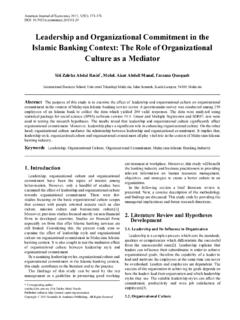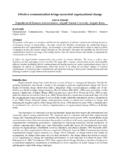Transcription of Impact of Organizational Culture on Employee …
1 ISSN: 2306-9007 Awad & Saad (2013) 168 Impact of Organizational Culture on Employee performance ALHARBI MOHAMMAD AWADH University Technology Malaysia International Business School, Malaysia E-mail: ALYAHYA, MOHAMMED SAAD University Utara Malaysia College of Business Malaysia. Email: Abstract Aim of the study: The relationship between Organizational Culture and performance has been study and a clear link between them has been identified by certain researcher s research. The main aim of research article is to identify and measure strong relationship between performance and Organizational Culture . Methodology: Literature review is adopted as methodology to assess the Culture of an organization impacts upon process, employees and systems. Findings: Certain dimensions of Culture have been identified so far and research shows that value and norms of an organization were based upon Employee relationship .
2 The goal of an organization is to increase level of performance by designing strategies. The performance management system has been measured by balance scorecard and by understanding nature and ability of system Culture of an organization have been identified. Recommendation: The strong Culture of an organization based upon managers and leaders help in improving level of performance . Managers relate organization performance and Culture to each other as they help in providing competitive advantage to firms. Keywords0:0 Impact , Organization0 Culture , Organization0 performance , Employee s Commitment, Organizational goals. Introduction Organizational development has certain factors that improve sustainability on basis of effectiveness. The improvement in productivity leads to Employee commitment as norms, values and objectives helps in improving Culture of an organization.
3 The system of organization was based upon effective establishment of Culture that keep learning environment strong. The performance of employees improves by establishment of strong Culture of an organization. The Employee performance would be considered as backbone organization as it leads to its development effectively. The loyalty of Employee relies upon knowledge and awareness of Culture that improves behaviour of organization (Brooks, 2006) Organization Culture have first time been identified by Administrative Science quarterly (Pettigrew, 1979). The value and norms of Employee s basis upon management identification that help in improving Employee performance . The awareness of quality helps in improving Organizational and Employee development. Organizational Culture The different attributes of Culture have been arranged on basis of norms and attitudes which help in differentiating one firm from another.
4 (Forehand and von Gilmer, 1964) The process of thinking helps in establishing one member from another on basis of cognitive thinking (Hofstede, 1980). The success guidance based upon different values and norm that makes Culture effective (Schein, 1990). The set of beliefs, behaviours, norms and values helps in making Culture most effective (Kotter and Heskett ,1992). The knowledge of Culture have been gained through understanding and beliefs on basis of large groups. I nternational eview of anagement and usiness esearch ol. 2 ISSN: 2306-9007 Awad & Saad (2013) 169 Culture is defined as a mixture of values, sets, beliefs, communications and explanation of behaviour that provides guidance to people. The main idea of Culture comes from sharing in learning processes that have been based upon systematic allocation of resources.
5 (Titiev, 1959) The cognitive systems of human that helps in improving thinking and decision making were based upon organization Culture . (Pettigrew 1979) The multifaceted set of beliefs, assumptions and values helps in presenting different level of Culture by conducting business at an effective manner. The normative glue based upon organization Culture helps in holding overall management effectiveness.( Tichy 1982). The concept of effective organization Culture helps in improving business decisions. The survival of Culture in an organization lies upon national and foreign Culture differentiation in Culture management. (Schein, 1990) The Culture of organization has been affected by attitudes, norms and beliefs that lead to strong communication between employees. Now a day s organization Culture has generally been interrelated to management. (Kotter and Heskett, 1992).The two essential factors that lead to effective Culture management include structural stability and integration of superior standard of organization Culture .
6 (Schein, 1995) Certain characteristics of organization Culture have been established in which set of norms, values and beliefs helps in perfect association between them. (Hodgetts and Luthans, 2003) At different level of organization Culture different background, ethics and racial differences Impact upon performance . The similar organization Culture with different backgrounds has common set of values and beliefs to be effected by organization systems. (Robbins & Sanghi, 2007) The attraction of organization norms, values and beliefs have strong affect upon performance and sustainability. (Stewart, 2010) The norms of employees Impact upon sustainable performance and management of organization Culture as it leads to attainment of profitability. Different kinds of cultures have been defined as followed: Counter Culture The values and beliefs of organization Culture which were shared among different management departments and managers were forced to gain advantage from them come under countercultures.
7 (Kerr, J., & Slocum, J. W., Jr. 2005) The organization performance based upon contribution of strong Culture leads to strong association between performance and management. Sub Culture Subcultures have been defined as organization segments with different sets of norms, values and beliefs on basis of geographical areas, job requirements and department goals.(Schein,1995) The commitment of employees towards organization basis upon Employee perception that affects upon Culture . (Lok, Westwood and Crawford, 2005) The social interaction of workplace outside organization considers well for some groups. Strong Culture The same type of values and beliefs which an Employee holds in Culture must be considered strong. The beliefs and values of organization were considered strong when Employee embraces greater part of Culture . (Deal and Kennedy, 1982) The reduction in gaps on Employee relationship has been agreed with managers so far.
8 The rules in organization must be considered important for employees. The policies, procedures and objectives designed by top managers must influence upon behaviour of employees so that competitive advantage have been gained Weak Culture The loosely knit organization cultures that helps in pushing thought, attitudes and beliefs of individuals to be more innovative. The valuable asset contributes to growing needs and wants of Culture management. I nternational eview of anagement and usiness esearch ol. 2 ISSN: 2306-9007 Awad & Saad (2013) 170 The loosely joined Culture based upon values and beliefs have association with perfect sets. (Deal and Kenndy 1982) The diversity between personal objectives and Organizational goals has creative management of rules and procedures so that perfect association have been created between them.
9 Dimension of Organizational Culture In order to elaborate findings IBM employees were gathered from more than 50 countries so that organization Culture on basis of dimensions would be perfectly analyzed. (Hofstede s ,1980) The four dimensions of organization Culture were as followed: Power distance: It is defined as degree of Employee and management behaviour that have been based upon perfect relationship between formal and informal set of planning action. Individualism: In this dimension difference between organization interest and self interest have perfectly been matched. Uncertainty avoidance: The uncertainty and ambiguity based upon tolerance helps in mitigating willingness of people. Masculinity: It comes in avoidance of caring and promotion rather than level of success based upon challenges, insolence and ambition. In 1998 Hofstede and Bond identified fifth dimension in which 23 countries long and short term orientation have perfectly been analyzed.
10 The Organizational behaviour relates to practitioners values and beliefs based upon Culture factors and norms that effects upon personality and performance of organization. (Sondergaard, 1994) The cultural factors and personality impacts upon behaviour and sustainability of organization (Schwartz,1994) The models developed by Hofstede in 1980 presents 38 countries studies in which strong relationships of Culture have been identified. From these classifications two different kind of dimensions have been identified such as : Affective & intellectual while secondly self enhancement and self transcendence . The standards based upon cultures and societies present contractual relationship between life and work. The standards based upon cultural association leads to perfect association between performance and management. More than 30 companies from 50 different countries have been identified (Trompanaars 1993).
